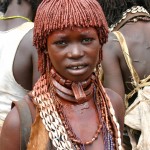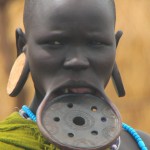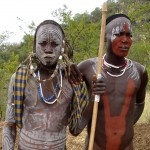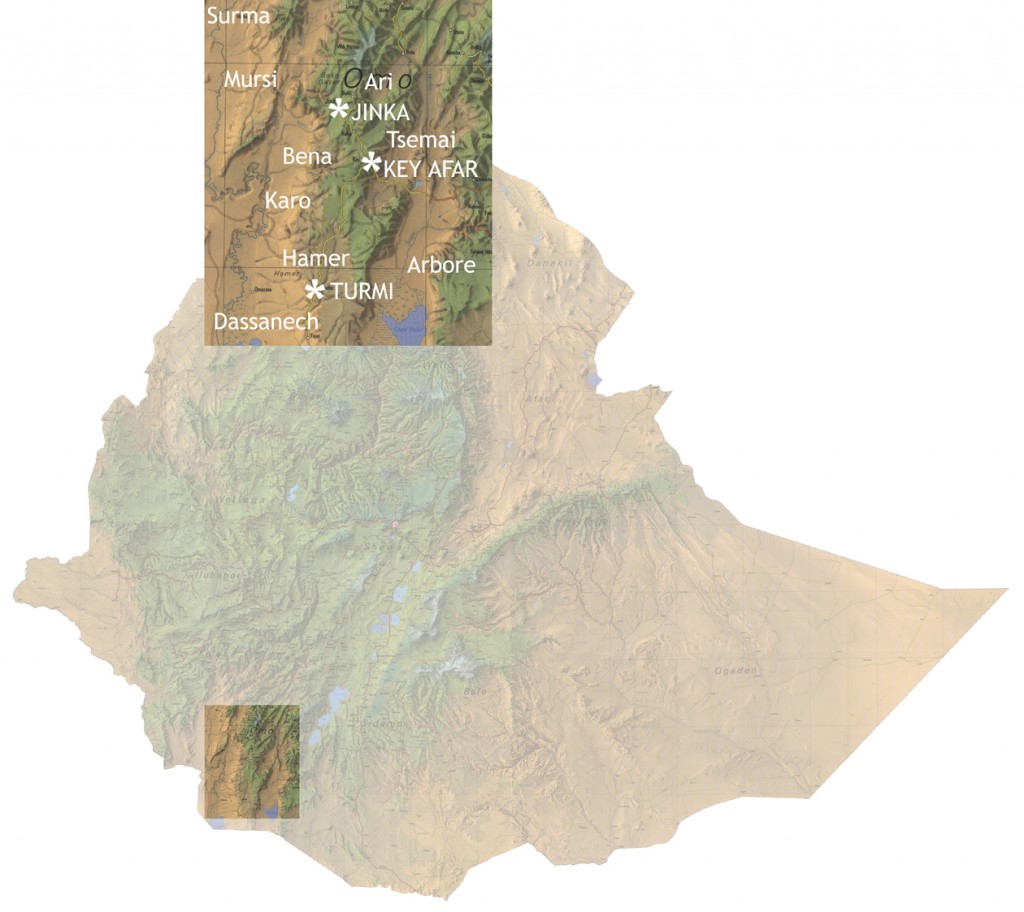Incredibly fascinating and unique in its own way, the Omo Valley has very little in common with the lush, green urbanized plateau of Christian Ethiopia. Vast steppes and nativeness prevails: it’s a piece of Africa as it once was, far from any civilization.
Still today, some two-dozen tribes live in the region along the lower reaches of the Omo River in accordance with ancient traditions. They continue to practice the customs of their ancestors, which is also shown in their dress. They paint and decorate their bodies in wild, colourful and sometimes excessive ways. The number of members in each tribe ranges from tens of thousands to only 500. Each tradition has their own style, traditions and rituals. This is also reflected in the linguistic diversity of the region: around 30 different language groups exist here.
The Hamer * This 35,000-member tribe lives in the area east of the Omo River reaching to Lake Chew Bahir, near the Kenyan border. The Hamer women are particularly pleasing to the eye. Their hair hangs around the neck and forehead in thick, bronze-coloured strands of hair. Their leather skirts are brightly decorated with colourful ribbons tied around their waists and copper bracelets fit snugly around their arms and wrists. Married women wear thick, heavy copper necklaces.
The men, in contrast, are relatively unadorned, unless a dance or ceremony is taking place, when they will paint their bodies bright white with  paint. The most important ceremony for the Hamer is the ‘Bull Jumping’, a rite of passage for young men. On the third day, the festival reaches its climax. Young girls drink and dance themselves into a trance, provoking the men to beat them with sticks, goading them on until they bleed. In the afternoon, up to 30 bulls are lined up side by side. Naked, the young man being initiated is swung onto the back of the first bull. From there, he jumps on the back of each bull until he reaches the end. This must be repeated three times until the young man is initiated and can successfully marry.
paint. The most important ceremony for the Hamer is the ‘Bull Jumping’, a rite of passage for young men. On the third day, the festival reaches its climax. Young girls drink and dance themselves into a trance, provoking the men to beat them with sticks, goading them on until they bleed. In the afternoon, up to 30 bulls are lined up side by side. Naked, the young man being initiated is swung onto the back of the first bull. From there, he jumps on the back of each bull until he reaches the end. This must be repeated three times until the young man is initiated and can successfully marry.
The Mursi * The Mursi number about 5,000 and populate the area between the Omo and Mago Rivers. The Mursi are most famous for their unconventional jewellery worn in the lips of women. At the age of 16-20 years a Mursi girl will have a small slit made just under her lower lip. This small slit is continually widened, a small peg is inserted and eventually a larger one. Once the slit is large enough, the peg is replaced by a small circular disk, which is also replaced by larger and larger disks over time. The optimal size disk is reached when it measures a diameter of about 15 centimetres. The trouble seems to pay off because the larger the disk, the greater the value of a Mursi bride.
jewellery worn in the lips of women. At the age of 16-20 years a Mursi girl will have a small slit made just under her lower lip. This small slit is continually widened, a small peg is inserted and eventually a larger one. Once the slit is large enough, the peg is replaced by a small circular disk, which is also replaced by larger and larger disks over time. The optimal size disk is reached when it measures a diameter of about 15 centimetres. The trouble seems to pay off because the larger the disk, the greater the value of a Mursi bride.
In addition to the lip disks, women will also often wear disks as earrings, as well as opulent pendants made of shells, glass beads or silver bangles. Wild patterns of white, red and brown decorate the remaining free areas of the body.
Men, on the contrary, must demonstrate their fighting skills and abilities. In order to marry, every Mursi man must win a stick fight, called a donga. This ritual is common among all Surma people, which include the Mursi.
The Surma * With their bodies painted in white chalk paste they battle their opponents in a  ritual stick fight (‘donga’). Armed with two-metre long sticks with phallus-like points, the opponents begin to fight. In earlier times, this fight could even lead to the death. However today, usually the beaten pronounces defeat early enough. The winner is then carried away by unmarried girls to decide which of them will marry him. The loser must wait for another opportunity to win at donga in order to be eligible for marriage.
ritual stick fight (‘donga’). Armed with two-metre long sticks with phallus-like points, the opponents begin to fight. In earlier times, this fight could even lead to the death. However today, usually the beaten pronounces defeat early enough. The winner is then carried away by unmarried girls to decide which of them will marry him. The loser must wait for another opportunity to win at donga in order to be eligible for marriage.
In addition, the Tsemai and Arbore, the Ari, Bumi and Bena tribes are all settled in the Omo Valley region, as well as the Daasanach and the Karo, known for their lively, red-spotted body paint. Weekly markets in the settlements offer a great opportunity to experience the colourful mix of the tribes up close. .
.
..
Travel Length: At least eight days should be planned from Addis Ababa (two days are needed for each trip there and back). For a detailed description for a possible course of travel, visit OUR TOURS: The People of the South – 9 Days in the Omo Valley. Alternatively, it is possible to fly to Jinka and drive from there.
Travel Season: The ritual ceremonies of most tribes are held before and after the rainy season, roughly from July to February. In order to witness these unique festivals, be sure to plan your trip accordingly. The best known of all the ceremonies is the Hamer Bull Jumping ceremony, which usually takes place only on market days (in the city of Turmi this is Monday). Stick fights often take place in August. In addition, during the middle of the rainy season in mid-April and May the Omo Valley is possibly impassable. Note that the rainy season can also shift.
Market Days: Mondays for Turmi and Karat-Konso; Tuesdays for Dimeka (wood market); Thursdays in Key Afar; Saturdays for Dimeka (Women’s Market), Chencha, Jinka and Karat-Konso.
Accommodation: There are some lodges in the area, as well as hotels in the towns. Camping is also an option as many of the hotels are of a lower standard and can often be relatively expensive.
.
.

